Integrate Azure Key Vault with Azure Pipelines
Azure Key Vault provides secure storage and management of sensitive data, such as keys, passwords, and certificates. Azure Key Vault includes support for hardware security modules and a range of encryption algorithms and key lengths. By using Azure Key Vault, you can minimize the possibility of disclosing sensitive data through source code, a common mistake developers make. Access to Azure Key Vault requires proper authentication and authorization, supporting fine-grained permissions to its content.
In this lab, you will see how you can integrate Azure Key Vault with Azure Pipelines by using the following steps:
- Create an Azure Key vault to store an ACR password as a secret.
- Configure permissions to allow the service principal to read the secret.
- Configure the pipeline to retrieve the password from the Azure Key vault and pass it on to subsequent tasks.
These exercises take approximately 30 minutes.
Before you start
You’ll need an Azure subscription, Azure DevOps organization, and the eShopOnWeb application to follow the labs.
- Follow the steps to validate your lab environment.
In this lab, you will:
- Deploy resources on your Azure subscription.
- Obtain read access to Azure Key Vault secrets.
Instructions
Exercise 1: Setup CI pipeline to build eShopOnWeb container
In this exercise, you’ll setup a CI YAML pipeline for:
- Creating an Azure Container Registry to store the container images
- Using Docker Compose to build and push eshoppublicapi and eshopwebmvc container images. Only eshopwebmvc container will be deployed.
Task 1: Setup and run CI pipeline
In this task, you will import an existing CI YAML pipeline definition, modify it, and run it. The pipeline will create an Azure Container Registry (ACR) and build/publish the eShopOnWeb container images.
-
Navigate to the Azure DevOps portal at
https://aex.dev.azure.comand open your organization. -
Navigate to the Azure DevOps eShopOnWeb project. Go to Pipelines > Pipelines and select New pipeline.
-
On the Where is your code? page, select Azure Repos Git (YAML) and select the eShopOnWeb repository.
-
On the Configure your pipeline page, select Existing Azure Pipelines YAML file. Provide the following path /.ado/eshoponweb-ci-dockercompose.yml and select Continue.
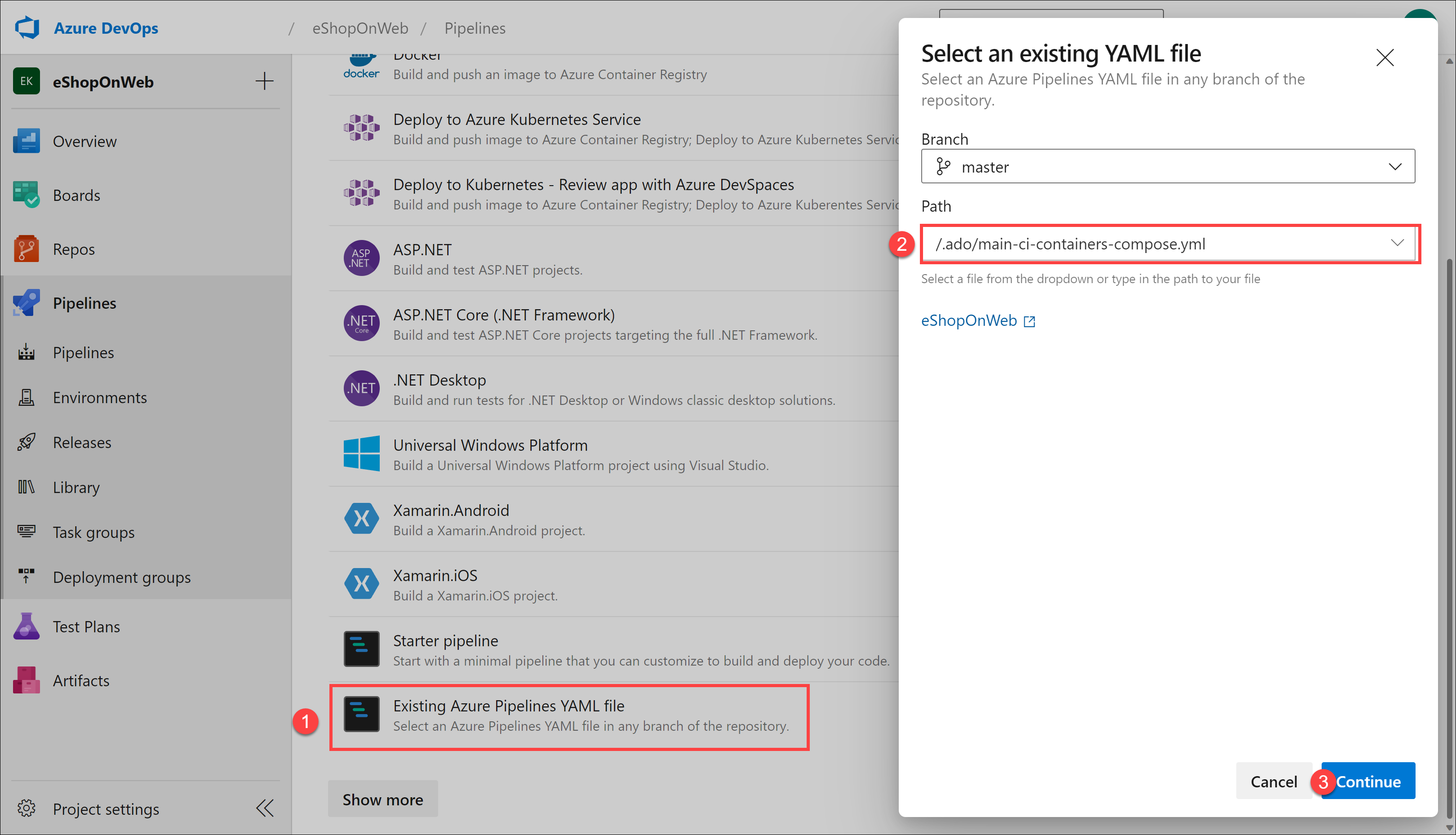
-
In the YAML pipeline definition, in the variables section, perform the following actions:
- Replace AZ400-EWebShop-NAME by rg-eshoponweb-secure
- Set the value of the location variable to the name of an Azure region you’ve been using in the previous labs of this course (for example centralus)
- Replace YOUR-SUBSCRIPTION-ID with your Azure subscription Id
-
Select Save and Run and choose to commit directly to the main branch.
-
Select Save and Run again.
Note: If you choose to create a new branch, you will need to create a pull request to merge the changes to the main branch.
-
Open the pipeline. If you see the message “This pipeline needs permission to access a resource before this run can continue to Create ACR for images”, select View, Permit and Permit again. The pipeline will be run in a few minutes.
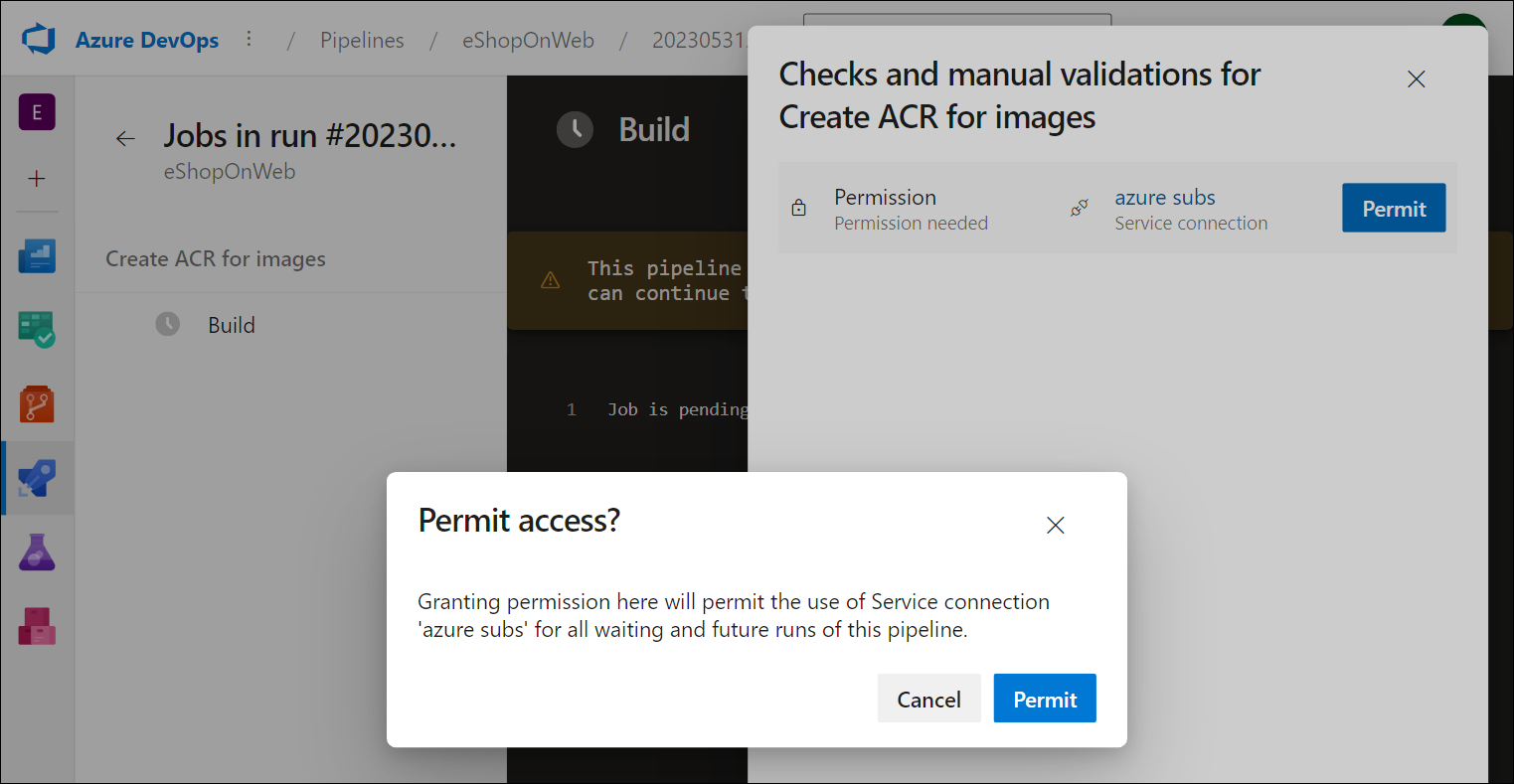
-
Wait for the pipeline run to complete. This might take a few minutes. The build definition consists of the following tasks:
- AzureResourceManagerTemplateDeployment uses bicep to create an Azure Container registry.
- PowerShell task take the bicep output (acr login server) and creates pipeline variable.
- DockerCompose task builds and pushes the container images for eShopOnWeb to the Azure Container registry .
-
Your pipeline will by default have the name based on the project name. Rename it to eshoponweb-ci-dockercompose in order to identify the pipeline better.
-
Once the pipeline run completes, use the web browser to navigate to the Azure Portal, open the rg-eshoponweb-secure resource group, and select the entry representing the Azure Container Registry (ACR) deployed by the pipeline.
Note: In order to view repositories in the registry, you need to grant to your user account a role that provides such access. You will use for this purpose the AcrPull role.
-
On the Container registry page, select Access control (IAM), select + Add and, in the drop-down list, select Add role assignment.
-
On the Role tab of the Add role assignment page, select AcrPull and then select Next.
-
On the Members tab, click + Select members, select your user account, click Select, and then select Next.
-
Select Review + assign and, once the assignment successfully completes, refresh the browser page.
-
Back on the Container registry page, in the vertical menu bar on the left, in the Services section, select Repositories.
-
Verify that the registry contains images eshoppublicapi and eshopwebmvc. You will only use eshopwebmvc in the deploy phase.
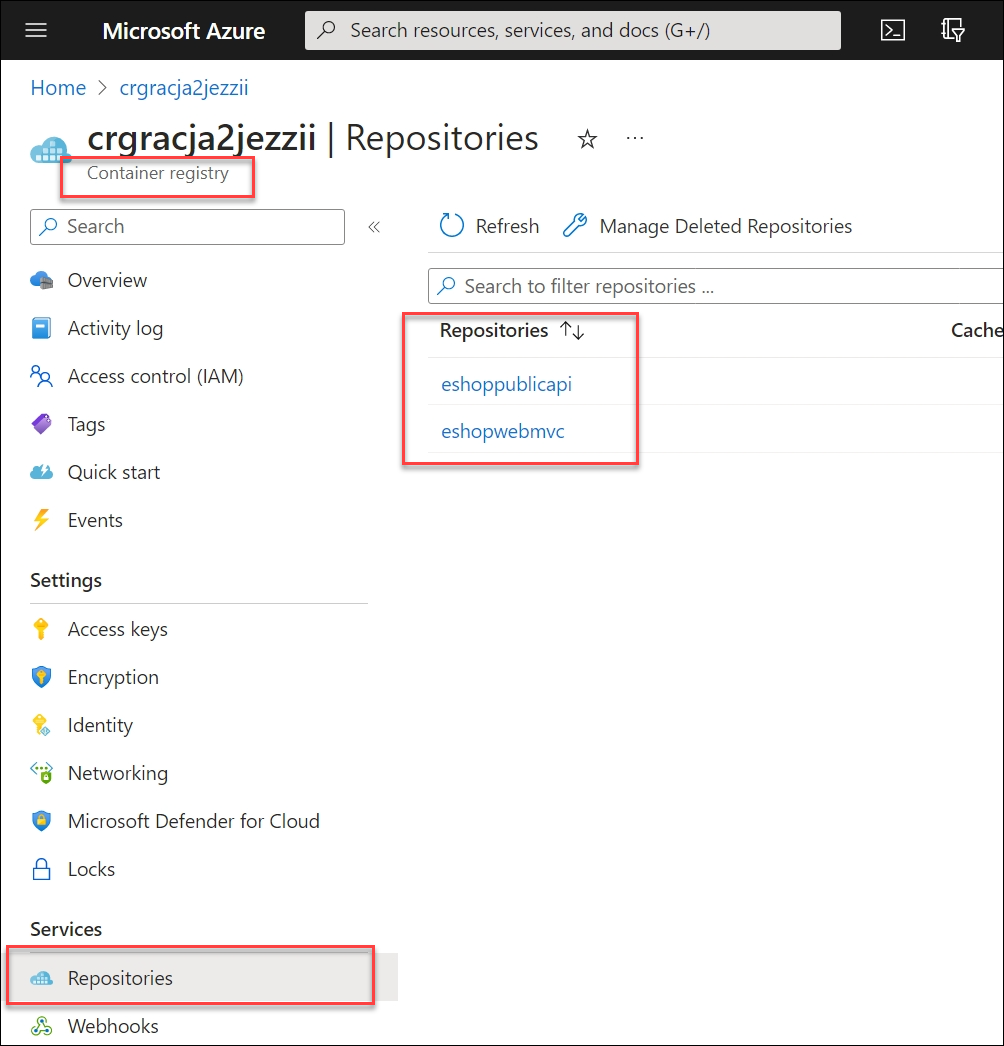
-
On the Settings, select Access Keys, enable the Admin user checkbox, and copy the username and Registry name values, which will be used in the following task, as you will add it as a secret to Azure Key Vault.
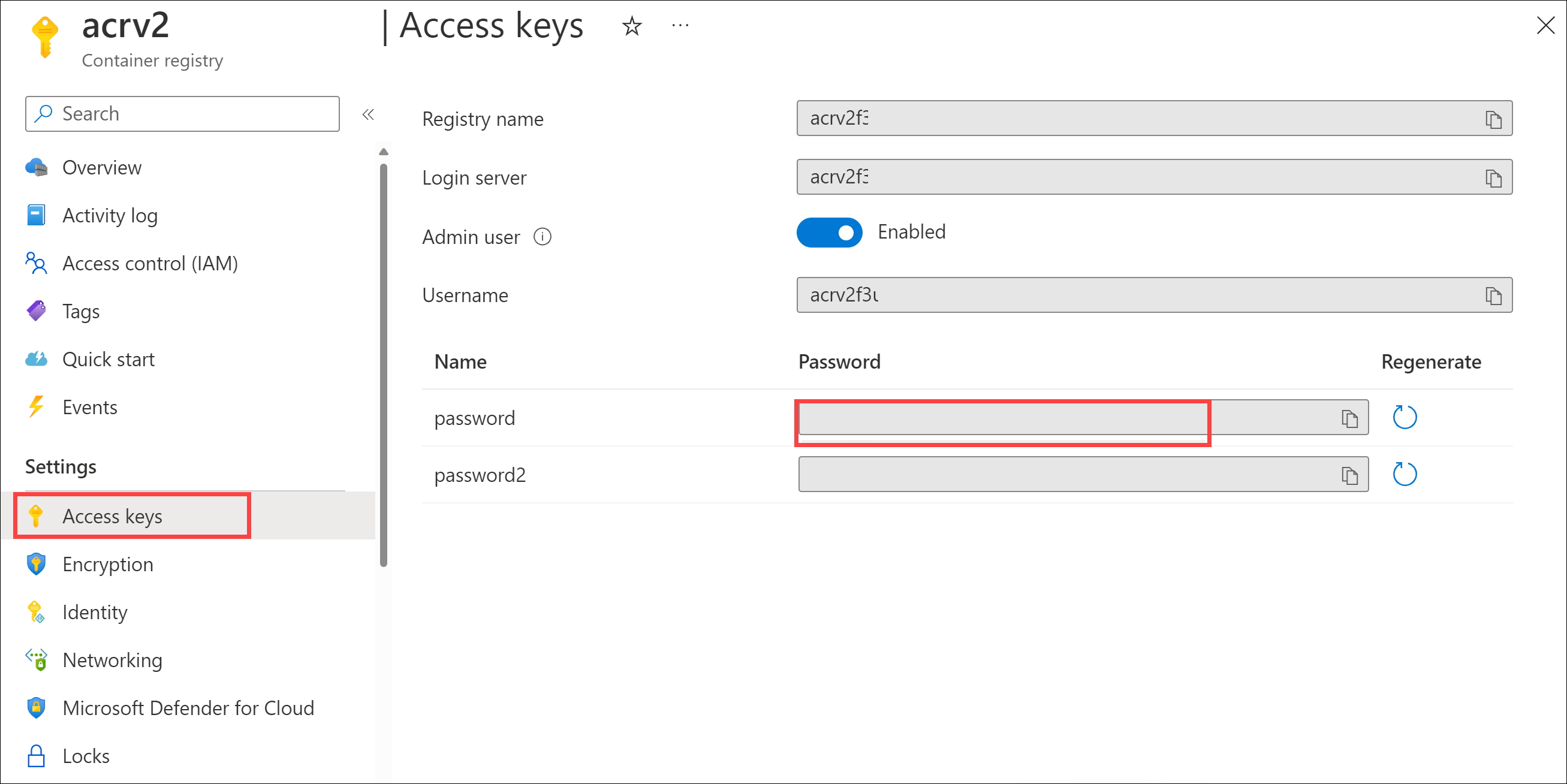
-
On the same page, record the value of Registry name. You will need it later in this lab.
Task 2: Create an Azure Key Vault
In this task, you will create an Azure Key vault by using the Azure portal.
For this lab scenario, we will have an Azure Container Instance (ACI) that pull and runs a container image stored in Azure Container Registry (ACR). We intend to store the password for the ACR as a secret in the Azure Key vault.
-
In the Azure portal, in the Search resources, services, and docs text box, type Key vaults and press the Enter key.
-
Select Key vaults blade, click on Create key vault.
-
On the Basics tab of the Create key vault blade, specify the following settings and click on Next:
Setting Value Subscription the name of the Azure subscription you are using in this lab Resource group the resource group name rg-eshoponweb-secure Key vault name any unique valid name, like ewebshop-kv Region the same Azure region you chose earlier in this lab Pricing tier Standard Days to retain deleted vaults 7 Purge protection Disable purge protection -
Click on Next: Access configuration.
-
Select Vault access policy in the Permission model section.
-
In the Access Policies section, select + Create to setup a new policy.
Note: You need to secure access to your key vaults by allowing only authorized applications and users. To access the data from the vault, you will need to provide read (Get/List) permissions to the previously created service principal that you will be using for authentication in the pipeline.
- On the Permission blade, check Get and List permissions below Secret Permission. Select Next.
- On the Principal blade, search and select your user, select Next and Next again.
- On the Review + create blade, select Create
-
Back on the Create a Key Vault blade, select Review + Create > Create
Note: Wait for the Azure Key vault to be provisioned. This should take less than 1 minute.
-
On the Your deployment is complete blade, select Go to resource.
-
On the Azure Key vault blade, in the vertical menu on the left side of the blade, in the Objects section, select Secrets.
-
On the Secrets blade, select Generate/Import.
-
On the Create a secret blade, specify the following settings and select Create (leave others with their default values):
Setting Value Upload options Manual Name acr-secret Value ACR access password copied in previous task -
Wait for the secret to be created.
Task 3: Create a Variable Group connected to Azure Key Vault
In this task, you will create a Variable Group in Azure DevOps that will retrieve the ACR password secret from Key Vault using the Service Connection (Service Principal)
-
Navigate to the Azure DevOps portal at
https://aex.dev.azure.comand open your organization. -
Navigate to the Azure DevOps project eShopOnWeb.
-
In the vertical navigational pane of the Azure DevOps portal, select Pipelines > Library. Select + Variable Group.
-
On the New variable group blade, specify the following settings:
Setting Value Variable Group Name eshopweb-vg Link secrets from Azure key vault as variables enable Azure subscription Available Azure service connection > azure subs Key vault name the name you assigned to the Azure Key vault in the previous task -
Click on the Authorize button.
-
Under Variables, select + Add and select the acr-secret secret. Select OK.
-
Select Save.
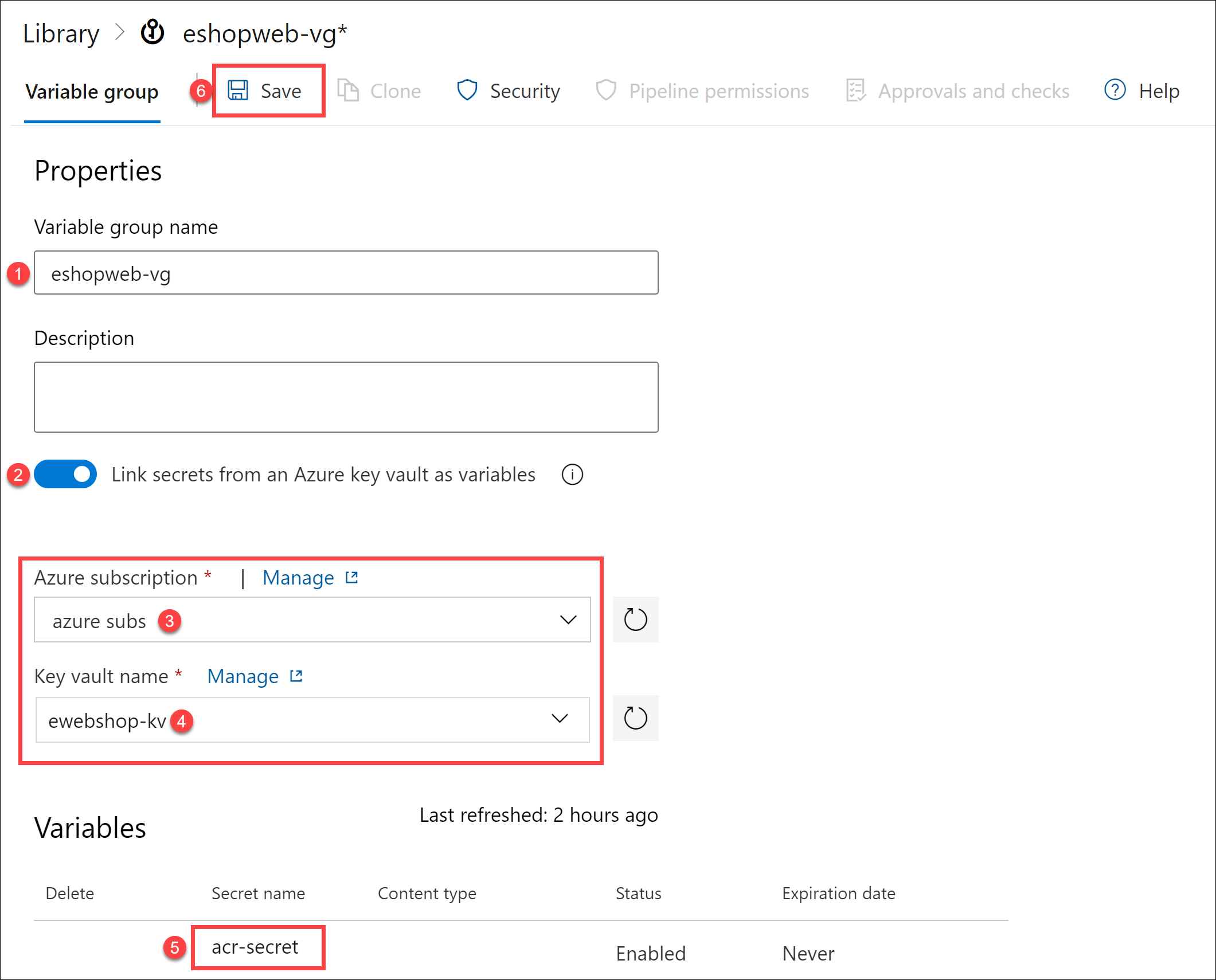
Task 4: Setup CD pipeline to deploy container in Azure Container Instance(ACI)
In this task, you will import a CD pipeline, customize it and run it for deploying the container image created before in an Azure Container Instance.
-
In the Azure DevOps portal displaying the eShopOnWeb project, select Pipelines > Pipelines and then select New Pipeline.
-
On the Where is your code? page, select Azure Repos Git (YAML) and then select the eShopOnWeb repository.
-
On the Configure your pipeline page, select Existing Azure Pipelines YAML file. Provide the path /.ado/eshoponweb-cd-aci.yml and select Continue.
-
In the YAML pipeline definition, in the variable section, perform the following actions:
- Set the value of the location variable to the name of an Azure region you used earlier in this lab, for example centralus.
- Replace YOUR-SUBSCRIPTION-ID with your Azure subscription Id
- Replace az400eshop-NAME with a globally unique name of the Azure Container instance to be deployed, for example, the string eshoponweb-lab-docker followed by a random six-digit number.
- Replace YOUR-ACR and ACR-USERNAME with your ACR registry name you recorded earlier in this lab.
- Replace AZ400-EWebShop-NAME with the name of the resource group you created earlier in this lab (rg-eshoponweb-secure).
-
Select Save and Run and then select Save and Run again.
-
Open the pipeline and note the message “This pipeline needs permission to access 2 resources before this run can continue to Docker Compose to ACI”. Select View and then select Permit twice (for each resource) to allow the pipeline to run.
-
Wait for the pipeline run to complete. This might take a few minutes. The build definition consists of a single task AzureResourceManagerTemplateDeployment, which deploys the Azure Container Instance (ACI) using a bicep template and provides the ACR login parameters to allow the ACI to download the previously created container image.
-
Your pipeline will take a name based on the project name. Rename it to eshoponweb-cd-aci in order to easier identify its purpose.
[!IMPORTANT] Remember to delete the resources created in the Azure portal to avoid unnecessary charges.
Review
In this lab, you integrated Azure Key Vault with an Azure DevOps pipeline by using the following steps:
- Provided access to Azure Key vault’s secrets and Azure resources from Azure DevOps.
- Ran two YAML pipelines imported from a Git repository.
- Configured pipeline to retrieve the password from the Azure Key vault using a variable group and re-used it on subsequent tasks.